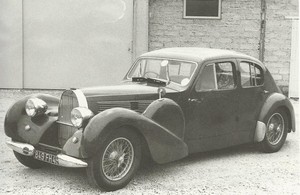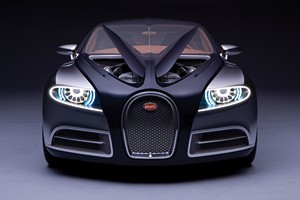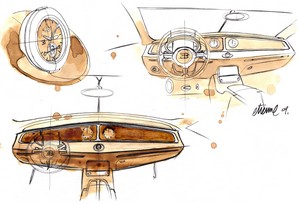|
By Dennis Simanaitis
ONE OF the first sports cars I rode in was a Bugatti Type 44, and I’ve been an enthusiast of Bugattis ever since.
 The marque has had two resurrections since its 1909 founding by Ettore Bugatti. Most of my lust for le Pur Sang (thoroughbred) of automobiles is directed toward the original Molsheim products. On the other hand, I also savor a post-Ettore Bugatti exotic, Romano Arcioli’s EB110. And there’s also one of the VW-consortium Bugattis on my savoring list.
The marque has had two resurrections since its 1909 founding by Ettore Bugatti. Most of my lust for le Pur Sang (thoroughbred) of automobiles is directed toward the original Molsheim products. On the other hand, I also savor a post-Ettore Bugatti exotic, Romano Arcioli’s EB110. And there’s also one of the VW-consortium Bugattis on my savoring list.
Alas, though, the Bugatti 16C Galibier is never to be.
No matter. Let’s celebrate this four-door exotic carrying a name with Pur Sang heritage. Its namesake, the Bugatti Type 57, was introduced in 1934, with much of its design attributed to Ettore’s son Jean. At the time, Le Patron was occupied with Bugatti railcars. On the left: Chassis of the Type 57. Image from Bugatti Magnum



Above, Galibiers of the original pilliarless design and a later one with conventional center pillars. Images from Bugatti Magnum.
In its first year of production, approximately 70 percent of the Type 57s carried factory coachwork, the Ventoux, Galibier, Atalante, Aravis and Stelvio models. Three are named for Alpine passes: the Aravis (4879 ft.), Galibier (8678 ft.) and Stelvio (9045 ft.); Ventoux (6273 ft., 3766-ft. prominence) is another Alpine peak and site of a hillclimb. Atalanta was a Greek huntress. The Galibier was the sole four-door of the series, originally in pillarless form.
Most Type 57s were powered by a twincam 3.3-liter inline-eight, later supercharged in 57C form. In 1939, a Type 57C Galibier proved capable of exceeding 120 mph. No mean achievement for an elegant four-door sedan at the time. (Still high praise for the Jaguar XK-120 sports car a decade later.)



Celebrating the centenary of the Bugatti factory’s founding in September 2009, its latter-day VW-owned counterpart introduced the 16C Galibier Concept at the company’s headquarters in Molsheim, France. Two months later, the car was presented to “customers and opinion-makers in Los Angeles.” I was fortunate to be included among the latter.
The 16C got its name from its 8.0-liter W-16 powerplant with twin supercharging. Among the engine’s innovative features was a flex-fuel nature, capable of operating on either gasoline or ethanol (a coming thing back then).
Bugatti claimed 16C power in excess of 1000 bhp delivered to an all-wheel drive. A top speed surpassing 235 mph was another claim.
A luxurious and artful place to be, though perhaps for the less-than-subtle (see steering-wheel hub).



The Galibier’s interior was replete in leather and wood, with tachometer and speedo centrally located so even rear-seat passengers could be impressed. Nor could anyone miss the Ettore Bugatti logo on the steering wheel hub.
In fact, the Galibier rear deck, otherwise styled with finesse, had its supersizing too. I asked my hosts at the intro whether Pur Sang enthusiasts might prefer something a bit less garish in the matter of logo and was told, more’s the pity, that customers wanted it this way.
 Other ostentation, I could buy. Er… not really buy, you understand, but savor. For instance, the center-dash timepiece was removable, with a handsome leather strap to mount it on one’s wrist.
Other ostentation, I could buy. Er… not really buy, you understand, but savor. For instance, the center-dash timepiece was removable, with a handsome leather strap to mount it on one’s wrist.
Production plans for the 16C Galibier were on again/off again and off permanently by early 2014. A British Top Gear interview quoted Bugatti chief Dr. Wolfgang Schreiber saying, “We have talked many, many times about the Galibier, but… it would confuse our customers…. There will not be a four-door Bugatti.”
I believe I hear the sound of le Patron, spinning.
First published on SimanaitisSays.com, 2015
| 


